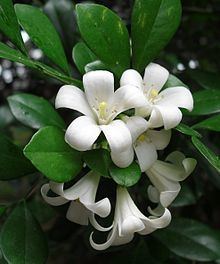Scientific name Murraya Rank Genus | Tribe Clauseneae Higher classification Clauseneae | |
 | ||
Lower classifications Orange jessamine, Curry tree | ||
Murraya paniculta orange jessamine at plantmark wholesale nurseries
Murraya is a genus of flowering plants in the citrus family, Rutaceae. It is distributed in Asia, Australia, and the Pacific Islands. The center of diversity is in southern China and Southeast Asia. The genus name commemorates the 18th-century German-Swedish herbal doctor Johan Andreas Murray, a student of Linnaeus.
Contents
- Murraya paniculta orange jessamine at plantmark wholesale nurseries
- Murraya paniculata chalcas or orange jessamine
- Description
- Uses
- Chemistry
- Diversity
- References
This genus is in the subfamily Aurantioideae, which also includes genus Citrus. It is in the subtribe Clauseninae, which are known technically as the remote citroid fruit trees.
Pretty to look at but Murraya is recorded as an invasive weed by many Australian councils. It is spread by birds, self-propagates and the roots are also invasive in seach of moisture. It invades natural habitats. This weed was introduced to areas in Australia and marketed as a easy to grow hedge which, when in flower, is highly allergenic to many of the population. Sufferers experience headache, blocked sinuses and breathing difficulties, etc. It may be in the citrus family but there's nothing healthy about a fully flowering Murraya hedge on a hot summer's night.[1]
Murraya paniculata chalcas or orange jessamine
Description
These plants are shrubs or trees. The leaves are pinnate, divided into several leaflets, and alternately arranged on the branches. The leaves are glandular, aromatic, and leathery to membranous in texture. The leaflets vary in shape and have smooth or toothed edges. The inflorescence is a panicle, cyme, or small raceme of flowers growing at the ends of branches or in the leaf axils; some flowers are solitary. The fragrant flowers have 4 or 5 sepals and white petals and up to 10 straight stamens. The fruit is a fleshy berry with pulp but without the juice vesicles present in some related fruits. It is up to 1.3 centimeters long and orange, red, or black.
Uses
Murraya species are used in landscaping. Some species can be grafted onto citrus rootstocks. Species have been used in traditional medicine, with various parts of the plants used to treat fever, pain, and dysentery. M. paniculata has been used to induce labor. It has been used in Cuba for painful inflammatory conditions.
Curry tree (M. koenigii) in particular has a number of uses. It is cultivated in India and Sri Lanka. The aromatic foliage, powdered leaves, and essential oil are used in Sri Lankan Cuisine and Indian cuisine as a flavoring for curries and meat, fish, and egg dishes. The oil is used in aromatherapy and added to soaps, hair tonics, and medicinal remedies.
Chemistry
Compounds isolated from Murraya include many types of coumarins and alkaloids. The novel alkaloid yuehchukene was found in M. paniculata, and it has since been isolated from other Murraya. It is found in red-fruited species with larger petals, but not in black-fruited species with smaller petals. Some species also contain the carbazole girinimbine.
M. koenigii has yielded a vast array of compounds, including carbazoles and carotenoids. The leaves alone have been found to contain such compounds as koenimbine, koenigine, koenine, koenidine, koenimbidine, murrayacine, murrayanine, murrayazoline, and murrayazolidine. The stems, roots, seeds, and fruit also contain many unique compounds. Coumarins, lipids, and the essential oil have also been analyzed. Many of the compounds have had different types of biological activities in lab tests.
Diversity
There are about 12 to 14 species in the genus.
Species include:
